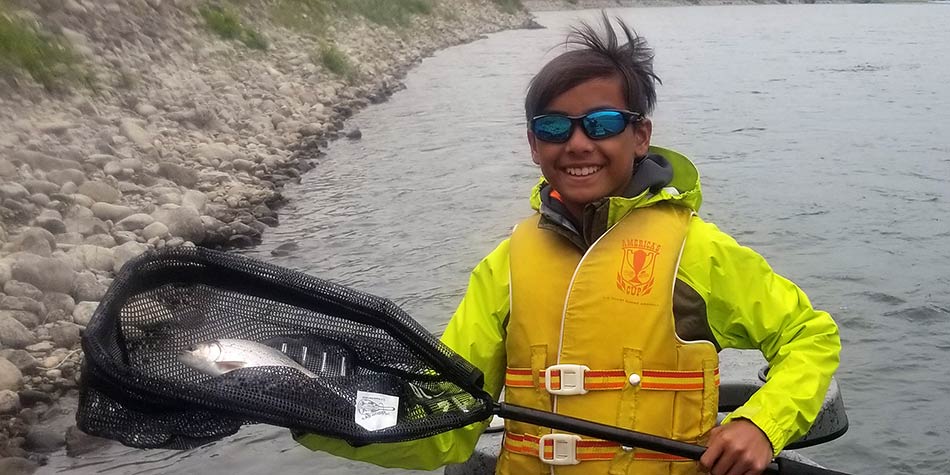Beginner fly fishing trips in Yellowstone Park and Montana are a great introduction to the sport, and our guides love teaching.
We are often asked “Do you take beginners?” Our answer: “Absolutely!” Probably 20% of our clients have never fly fished before. Montana and Yellowstone Park beginner fly fishing trips are a great way to get started right.
This region hosts a wide variety of places to fish, from tiny creeks to huge rivers and lakes, so it’s easy to find something that’s right for beginners, whether they’re looking for a first step on a lifetime fly fishing journey or just want to try it once.
Note that previous experience fishing with conventional tackle does not really help when it comes to fly fishing, especially with casting and line management. As such, potential clients with previous experience with spinning (conventional) tackle do indeed count as beginners when it comes to fly fishing.
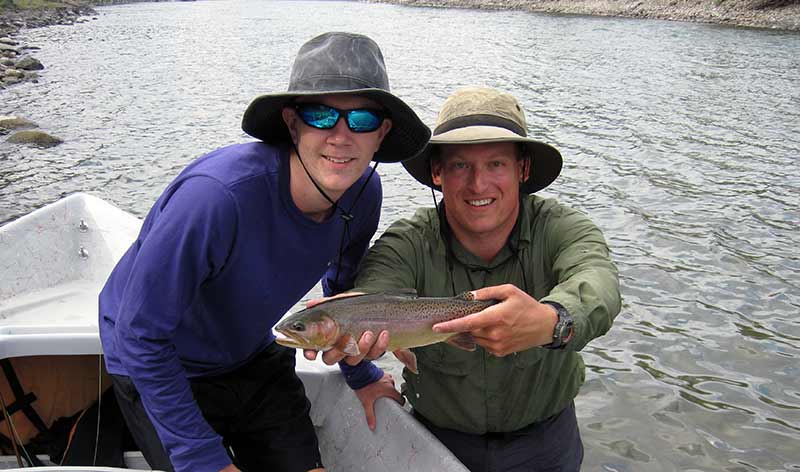
Pricing? What’s Included? What Should We Bring?
Beginner trips generally cost the same amount as all other trips of the same type. These rates are given on the introduction to our guide service page as well as the specific pages for each type of trip. One guide can handle one or two guests. More guests means more guides.
Rates include flies, tackle, transportation from your lodgings or a prearranged meeting point, water, soft drinks on request, and lunch on full-day trips
Rates do not include fishing licenses, Yellowstone Park access fees (if applicable), private water access fees (if applicable), wading gear, or alcoholic beverages. Wading gear may be rented from local shops (we can usually pick it up for you) if required. Old sneakers work fine on many beginner wading trips, and most summer floats don’t require wading gear at all.
The guided trip packing list page will give you a good idea what to bring. We’ll also send out a detailed itinerary when you book that lets you know exactly what you’ll need for your specific trip.
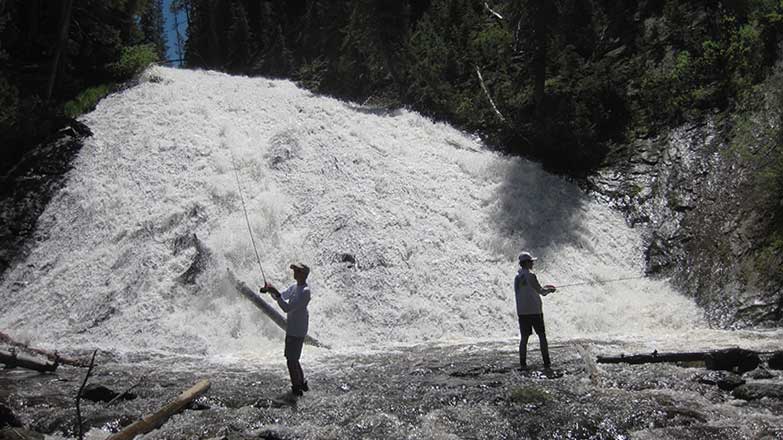
What Will We Learn on a Montana or Yellowstone Beginner Fly Fishing Trip?
- The elements of tackle: rod, reel, line, leader, tippet, and flies
- Rigging and the basics of caring for fly tackle
- Introduction to fly fishing knots
- Line and rod handling basics
- The standard overhead or “back” cast
- Basics of reading water: where fish are likely to live and why
- Basics of approaching the water: how to sneak up on fish, where to stand, and how to wade to avoid spooking your quarry
- Drift management basics: making your flies behave like real insects or baitfish
- Recognizing the signs of a fish striking, often both with dry (surface) flies and with subsurface flies.
- Setting the hook and playing fish
- Basics of unhooking and releasing fish without doing additional harm
- Extreme basics of aquatic insect entomology and fly selection based on conditions and season
Depending on how quickly members in the party pick up the above, trip duration, and trip type, we may also cover the following:
- Line mending and other more advanced elements of drift management
- More in-depth discussion of aquatic insect entomology, some discussion of baitfish behavior
- Tactics to retrieve snagged flies
- Introduction to roll casting (an additional cast) and possibly other advanced casts
- Safe wading basics
- Reviving exhausted fish before release
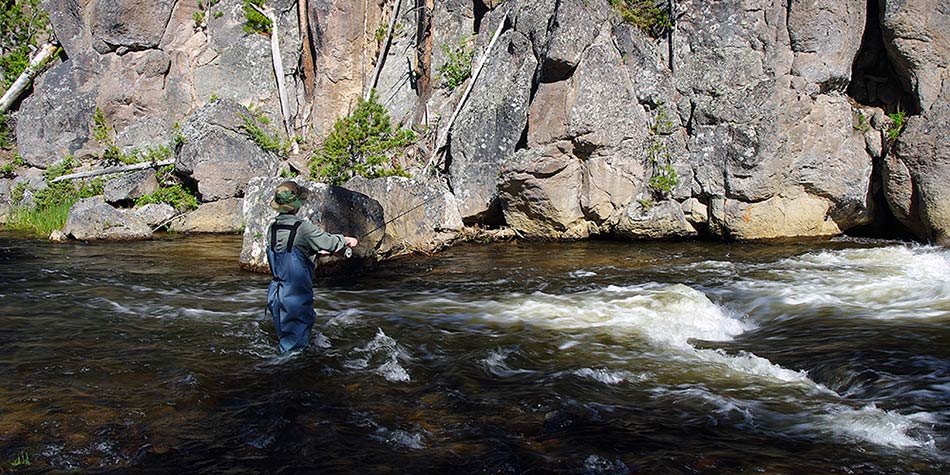
What Else Will We Experience on a Montana or Yellowstone Beginner Fly Fishing Trip?
Most beginners are visiting the Montana and Yellowstone area as part of a general vacation and care just as much about the scenery, geology, animals, and so on as they do about the fishing. As such, with beginners we tend to focus on “the extras” as well as the fish. While our guides are not trained ranger-naturalists, we only use experienced guides who have lived and fished this area for at least several years and have some tricks up their sleeves.
Therefore some combination of the following are also included on our Montana and Yellowstone beginner fly fishing trips, depending on what time of year it is, where we fish, and (in the case of the animals) pure dumb luck:
- Wildlife watching and photography
- Hiking, both on and off-trail
- Waterfall viewing, including of falls not visible to most visitors
- Geyser or hot spring viewing, including of lesser-known springs and vents
- Discussion of area history and archaeology, including the potential in a few areas of viewing Native American sites
- Berry-picking in season
- Animal antler and bone, and interesting rock and petrified wood collection (outside YNP) or viewing (inside YNP, where collection is banned)
- Beautiful mountain, canyon, and prairie scenery
- Whitewater thrills
Top Montana and Yellowstone Beginner Fly Fishing Trips
The remainder of this page gives some details about the top three trip options for beginners, in particular the types of trips that are best for certain clients at certain times of year. The time period in which they’re available or make the most sense for beginners is given in the heading for each trip type. The trips are listed in their overall popularity with beginners.
The following chart gives a general overview of when each trip (and beginner fishing overall) make the most sense.

At the bottom of each section, click or tap the link button if you’d like more information above each specific trip type mentioned to jump to the relevant page on our site.
If you’d rather just skip the rigamarole and talk to us about the best options for you at the time of year when you’re going to be here, give us a call.
“Beginner Brookies” Half-Day Family Trips (Late June through Mid-August)
Our most popular Yellowstone beginner fly fishing trips are our “beginner brookies” half-day trips in Yellowstone Park. On these trips, we take a short hike to a small stream to fish for small, numerous, enthusiastic (easy) brook trout.
These trips are ideal for families with kids, those who would like a low-stress introduction to fly fishing, those who would like a short but pretty hike in Yellowstone Park, those who will be moving on to a more-challenging trip soon and want something easy to start with, and those who are just looking to check fly fishing off their bucket lists in a pretty environment.
All beginner brookie trips are half-day hike & wade trips in Yellowstone Park. They generally involve hikes in the 1-2 mile range each way to access unpressured water and easy fishing. Most of these hikes are flat and easy, but more aggressive hikes open up more water and more pretty waterfalls.
On beginner brookie trips, most clients get between ten and fifty bites apiece on an average day. Some beginners catch thirty or more fish, and just about everybody catches at least a few. These fish are always small, however.
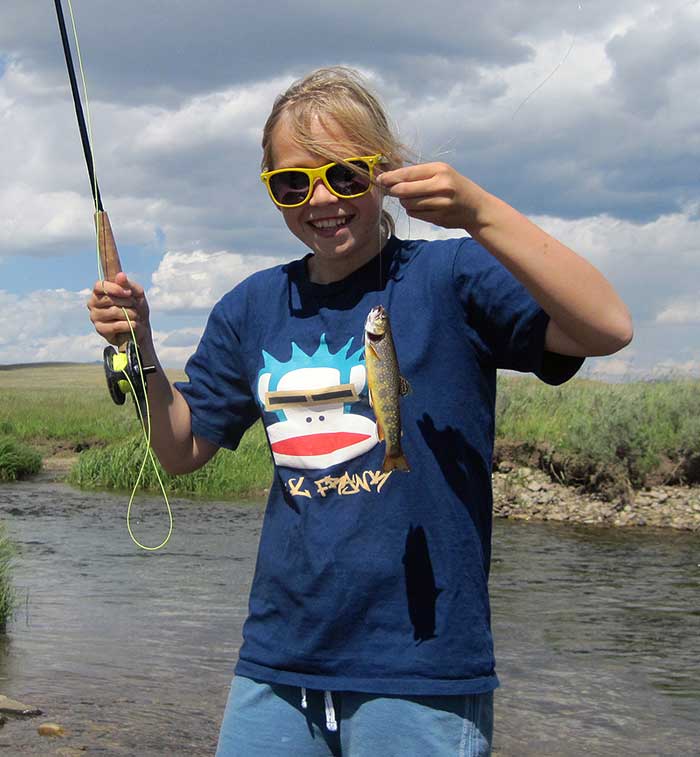
Beginner brookie trips run as half-days (though we sometimes fish for brook trout in the first half of a full-day trip, too). The fishing is generally better in the morning on these trips, with less competition from other anglers, so we meet between 7:00 and 9:00AM.
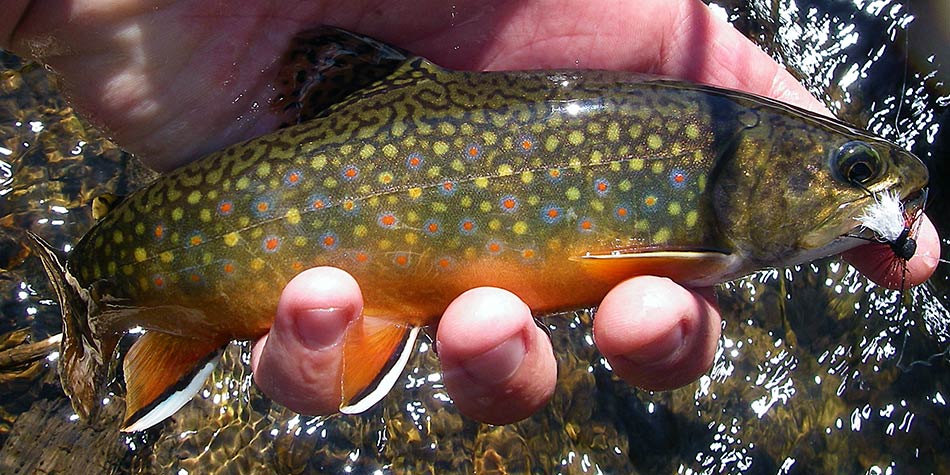
Brook trout are numerous, pretty, aggressive, and around here tend to live in beginner-friendly places, but they are small.
Standard Walk & Wade Trips (Almost Year-Round)
Public waters in the northern part of Yellowstone Park and near Livingston, Montana provide a wide range of fishing opportunities, scenery, and experiences suitable for half-day or full-day Montana or Yellowstone beginner fly fishing trips. Unlike “beginner brookie” trips, options are available for standard walk & wade trips year-round except during the May-June spring runoff. Even midwinter fishing is possible.
Beginners seldom catch as many fish on standard trips as they do on brookie trips. These fish are almost always larger and more challenging, however. This fact makes these trips better for beginners who want to focus on learning proper techniques rather than just catching as many fish as possible. All in all, a standard walk-wade is a better option for teens and adults who want to “dive right in” to fly fishing and expect they’ll continue in the sport, rather than younger kids and those who just want to check fly fishing off their life lists.
Both full-day and half-day options make sense during the core season, while from late fall through early spring, shorter “winter special” rates are available for trips including a couple hours on the water.
These trips usually take place on rough and tumble streams in Yellowstone Park or on the Yellowstone River outside the park, though many destinations are possible depending on client interests, where clients are staying, and what’s fishing well.
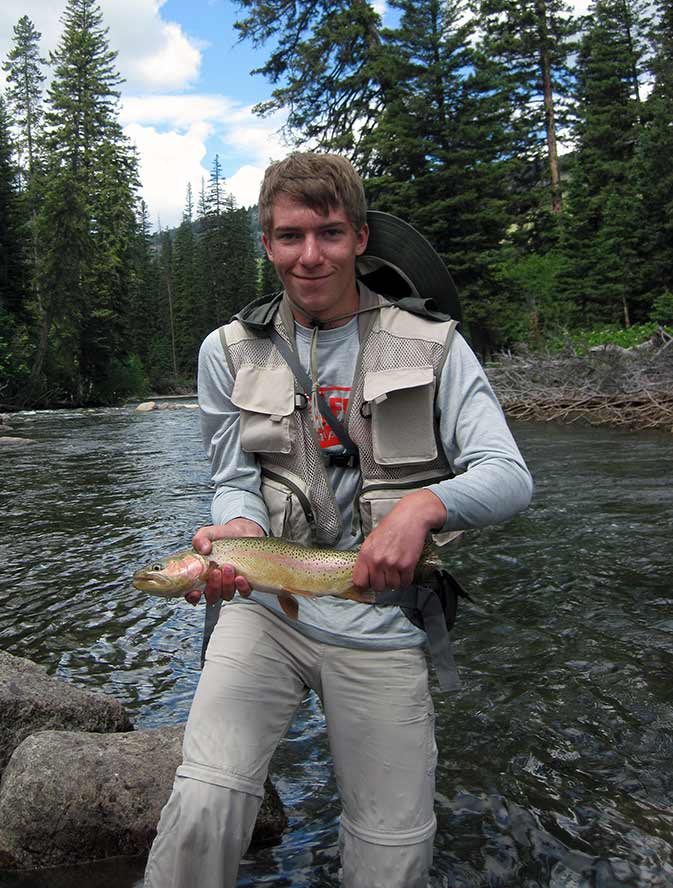
Destinations for our standard walk & wade trips suitable for eager beginners range from tiny creeks to alpine lakes, as do the types of tactics we might use, the fish we might catch, and the scenery and animal-viewing options available. This makes standard walk & wade trips our most flexible trip option for beginners. While the rough, boulder-bottomed streams fish best, we can fish gentler water if members of your party can’t handle rough stream banks.
Meeting times for these trips will range from 6:00AM to 9:30AM on full-day bookings, depending on the time of year and where we’re meeting, and between 6:00 and 11:00 for half-days.
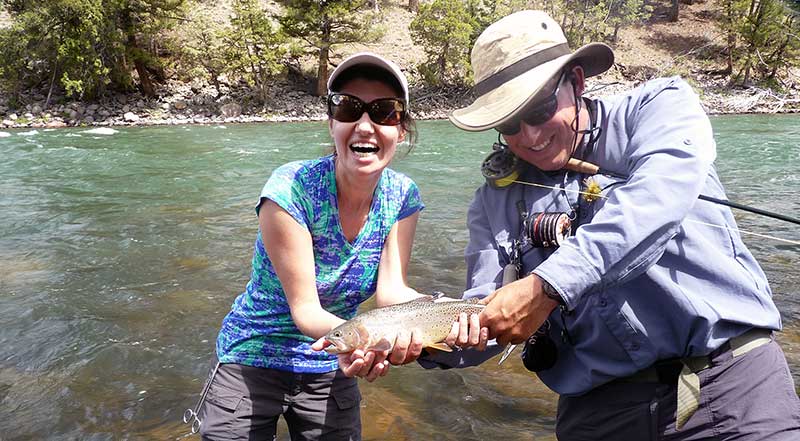
First fish on a fly, and a nice cutthroat, too!
River Float Trips (Late March through Early October)
Fly fishing float trips on local rivers are our most popular trips overall. They provide the most fishing time relative to travel time, the potential for both a lot of fish and larger fish, and great scenery along with the potential for whitewater thrills. As such, they’re pretty popular for Montana and Yellowstone beginner fly fishing trips as well as for experienced anglers.
That said, they offer less opportunities for beginner anglers to learn a wide range of techniques and are much faster-paced than other trips. They can also be overwhelming for kids due to the large and heavy nature of the tackle and large water that requires longer casts.
New fly fishers who don’t want to walk and want to focus primarily on catching fish – including potentially some big ones – with one major technique rather than learning lots of nitty-gritty details might like a float more than other options.
The float-fishing technique most-suited to beginners, called “indicator nymphing” involves fishing a strike indicator (glorified bobber) with a pair of subsurface flies imitating insects or baitfish. Because these flies typically produce the largest trout on all rivers, and the most trout overall over the course of a season, this is probably the single most effective fly fishing technique in general. Out of a moving boat, it’s also the easiest technique, since the guide can often maneuver the boat so that clients don’t have to cast as often or as accurately as with other techniques.
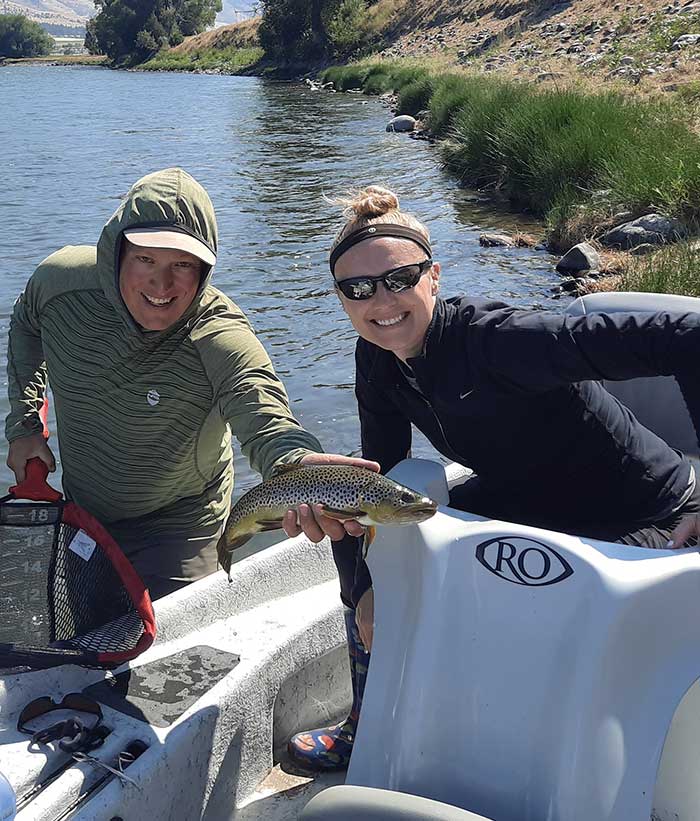
Larger trout are possible for beginners on float trips.
On the other hand, float-fishing with indicators is often considered the most boring method of fly fishing (until you hook a big fish), and since the guide does much of the work in getting the flies into position with this technique, clients don’t learn as much as they do on walk-wade trips. In addition, the casting involved with this technique tires many beginners quickly, since the flies, strike indicators, weight, and even the rods used on floats themselves are much heavier than those used on most beginner walk trips.
Most beginner floats run as half-day trips, though full-days make sense too. Just make sure to tell your guide if your arm is getting tired and we’ll let you know when to reel in and just enjoy the scenery for a while. On float trips we drift over both good areas and bad ones, and we’d rather you fish the good spots. Depending on the time of year and whether we’re running a full-day or half-day, we’ll want to start between 8AM and 1PM.
